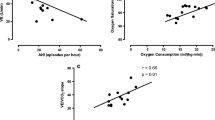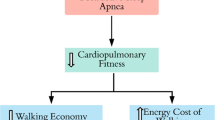Abstract
Purpose
Individuals with obstructive sleep apnea (OSA) have an altered hemostatic balance; however, the exercise response is less described. The purpose of this study is to determine the hemostatic response after acute aerobic exercise in obstructive sleep apnea.
Methods
Eighteen males (nine OSA vs. nine controls) were recruited from the university and local community. Individuals with evidence of cardiovascular, pulmonary, or metabolic disease were excluded. An apnea-hypopnea index (AHI) of >5 was a criterion for OSA. Subjects performed a treadmill exercise test at 35 and 70% predicted VO2 reserve during the morning hours. Pre-exercise blood samples were obtained after 15 min supine rest and within 2 min following exercise. Repeated measures ANOVA were performed for factor VIII antigen, tissue plasminogen activator (tPA) antigen, tPA activity, and PAI-1 activity. Correlational analysis compared resting and post-exercise hemostatic factors with age, BMI, and AHI.
Results
Mean AHI was 13.00 ± 12.6. No exercise × condition interactions were observed for hemostatic markers. There was a main effect for exercise in factor VIII, tPA antigen, and tPA activity in both groups. PAI-1 activity tended to be elevated in OSA (145%) compared to controls which remained after exercise (205%) (P = 0.05). Post-exercise FVIII/Ag correlated with BMI (r = 0.52), while resting tPA/Ag correlated with AHI (r = 0.49) and age (r = 0.50).
Conclusion
The hemostatic response after acute aerobic exercise is unaffected in mild OSA, although PAI-1 activity seems to be elevated, reducing fibrinolytic potential. BMI seems to correlate with FVIII/Ag, while tPA/Ag is associated with AHI and age.






Similar content being viewed by others
References
Somers VK, White DP, Amin R, Abraham WT, Costa F, Culebras A, Daniels S, Floras JS, Hunt CE, Olson LJ (2008) Sleep apnea and cardiovascular disease: an American heart association/American college of cardiology foundation scientific statement from the American heart association council for high blood pressure research professional education committee, council on clinical cardiology, stroke council, and council on cardiovascular nursing in collaboration with the national heart, lung, and blood institute national center on sleep disorders research (National Institutes of Health). J Am Coll Cardiol 52(8):686–717
White DP (2005) Pathogenesis of obstructive and central sleep apnea. Am J Resp Crit Care 172(11):1363–1370
Pataka A, Riha RL (2009) The obstructive sleep apnoea/hypopnoea syndrome—an overview. Resp Med 2(3):111–117
Young T, Finn L, Peppard PE, Szklo-Coxe M, Austin D, Nieto FJ, Stubbs R, Hla KM (2008) Sleep disordered breathing and mortality: eighteen-year follow-up of the Wisconsin sleep cohort. Sleep 31(8):1071–1078
Marin JM, Carrizo SJ, Vicente E, Agusti AG (2005) Long-term cardiovascular outcomes in men with obstructive sleep apnoea-hypopnoea with or without treatment with continuous positive airway pressure: an observational study. Lancet 365(9464):1046–1053
Baguet J-P, Hammer L, Lévy P, Pierre H, Launois S, Mallion J-M, Pépin J-L (2005) The severity of oxygen desaturation is predictive of carotid wall thickening and plaque occurrence. Chest 128(5):3407–3412
Drager LF, Bortolotto LA, Lorenzi MC, Figueiredo AC, Krieger EM, Lorenzi-Filho G (2005) Early signs of atherosclerosis in obstructive sleep apnea. Am J Resp Crit Care 172(5):613–618
Fox N, Ayas N, Park JE, Fleetham J, Ryan CF, Lear SA, Mulgrew A, Chan S, Hill J, Mancini GJ (2014) Carotid intima media thickness in patients with obstructive sleep apnea: comparison with a community-based cohort. Lung 192(2):297–303
Fox H, Purucker H-C, Holzhacker I, Tebtmann U, Bitter T, Horstkotte D, Graml A, Woehrle H, Oldenburg O (2016) Prevalence of sleep-disordered breathing and patient characteristics in a coronary artery disease cohort undergoing cardiovascular rehabilitation. J Cardpulm Rehabil 36(6):421–429
Folsom AR, Wu KK, Shahar E, Davis C (1993) Association of hemostatic variables with prevalent cardiovascular disease and asymptomatic carotid artery atherosclerosis. The Atherosclerosis Risk In Communities (ARIC) Study investigators. Arterioscl Throm Vas 13(12):1829–1836
Tracy RP, Arnold AM, Ettinger W, Fried L, Meilahn E, Savage P (1999) The Relationship of Fibrinogen and Factors VII and VIII to Incident Cardiovascular Disease and Death in the Elderly Results from the Cardiovascular Health Study. Arterioscl Throm Vas 19(7):1776–1783
Meade T, Ruddock V, Stirling Y, Chakrabarti R, Miller G (1993) Fibrinolytic activity, clotting factors, and long-term incidence of ischaemic heart disease in the Northwick Park Heart Study. Lancet 342(8879):1076–1079
von Kanel R, Loredo JS, Ancoli-Israel S, Mills PJ, Natarajan L, Dimsdale JE (2007) Association between polysomnographic measures of disrupted sleep and prothrombotic factors. Chest 131(3):733–739
Pinsky DJ, Liao H, Lawson CA, Yan S-F, Chen J, Carmeliet P, Loskutoff DJ, Stern DM (1998) Coordinated induction of plasminogen activator inhibitor-1 (PAI-1) and inhibition of plasminogen activator gene expression by hypoxia promotes pulmonary vascular fibrin deposition. J Clin Invest 102(5):919
Guardiola JJ, Matheson PJ, Clavijo LC, Wilson MA, Fletcher EC (2001) Hypercoagulability in patients with obstructive sleep apnea. Sleep Med 2(6):517–523
Bärtsch P, Haeberli A, Hauser K, Gubser A, Straub P (1988) Fibrinogenolysis in the absence of fibrin formation in severe hypobaric hypoxia. Aviat Space Envir MD 59(5):428–432
Giri S, Thompson PD, Kiernan FJ, Clive J, Fram DB, Mitchel JF, Hirst JA, McKay RG, Waters DD (1999) Clinical and angiographic characteristics of exertion-related acute myocardial infarction. JAMA 282(18):1731–1736
Mittleman MA, Maclure M, Tofler GH, Sherwood JB, Goldberg RJ, Muller JE (1993) Triggering of acute myocardial infarction by heavy physical exertion—protection against triggering by regular exertion. New Engl J Med 329(23):1677–1683
Iatridis SG, Ferguson JH (1963) Effect of physical exercise on blood clotting and fibrinolysis. J Appl Physiol 18(2):337–344
Acil T, Atalar E, Sahiner L, Kaya B, Haznedaroglu IC, Tokgozoglu L, Ovunc K, Aytemir K, Ozer N, Oto A (2007) Effects of acute exercise on fibrinolysis and coagulation in patients with coronary artery disease. Int Heart J 48(3):277–285
Rångemark C, Hedner JA, Carlson JT, Gleerup G, Winther K (1995) Platelet function and fibrinolytic activity in hypertensive and normotensive sleep apnea patients. Sleep 18(3):188–194
Medicine ACoS (2013) ACSM’s guidelines for exercise testing and prescription. Lippincott Williams & Wilkins, USA
Cohen R, Epstein S, Cohen L, Dennis L (1968) Alterations of fibrinolysis and blood coagulation induced by exercise, and the role of beta-adrenergic-receptor stimulation. Lancet 292(7581):1264–1266
Andrew M, Carter C, O’Brodovich H, Heigenhauser G (1986) Increases in factor VIII complex and fibrinolytic activity are dependent on exercise intensity. J Appl Physiol 60(6):1917–1922
Womack CJ, Paton CM, Coughlin AM, Nagelkirk P, Dejong AT, Anderson J, Franklin BA (2003) Coagulation and fibrinolytic responses to manual versus automated snow removal. Med Sci Sport Exer 35(10):1755–1759
Menzel K, Hilberg T (2011) Blood coagulation and fibrinolysis in healthy, untrained subjects: effects of different exercise intensities controlled by individual anaerobic threshold. Eur J Appl Physiol 111(2):253–260
Meade T, Cooper J, Stirling Y, Howarth D, Ruddock V, Miller G (1994) Factor VIII, ABO blood group and the incidence of ischaemic heart disease. Brit J Haematol 88(3):601–607
Rumley A, Lowe G, Sweetnam P, Yarnell J, Ford R (1999) Factor VIII, von Willebrand factor and the risk of major ischaemic heart disease in the Caerphilly Heart Study. Brit J Haematol 105(1):110–116
Thögersen AM, Jansson J-H, Boman K, Nilsson TK, Weinehall L, Huhtasaari F, Hallmans G (1998) High plasminogen activator inhibitor and tissue plasminogen activator levels in plasma precede a first acute myocardial infarction in both men and women evidence for the fibrinolytic system as an independent primary risk factor. Circulation 98(21):2241–2247
Shahar E, Whitney CW, REdline S, Lee ET, Newman AB, Javier Nieto F, O’CONNOR GT, Boland LL, Schwartz JE, Samet JM (2001) Sleep-disordered breathing and cardiovascular disease: cross-sectional results of the Sleep Heart Health Study. Am J Resp Crit Care 163(1):19–25
Marshall NS, Wong K, Cullen S, Knuiman MW, Grunstein RR (2014) Sleep apnea and 20-year follow-up for all-cause mortality, stroke, and cancer incidence and mortality in the Busselton Health Study cohort. J Clin Sleep Med 10(4):355–362
von Känel R, Loredo JS, Ancoli-Israel S, Dimsdale JE (2006) Association between sleep apnea severity and blood coagulability: treatment effects of nasal continuous positive airway pressure. Sleep Breath 10(3):139–146
Röcker L, Möckel M, Westpfahl K, Gunga H-C (1996) Influence of maximal ergometric exercise on endothelin concentrations in relation to molecular markers of the hemostatic system. Thromb Haemost 75(4):612–616
Cooper JA, Nagelkirk PR, Coughlin AM, Pivarnik JM, Womack CJ (2004) Temporal changes in tPA and PAI-1 after maximal exercise. Med Sci Sport Exer 36(11):1884–1887
Womack CJ, Rasmussen JM, Vickers DG, Paton CM, Osmond PJ, Davis GL (2006) Changes in fibrinolysis following exercise above and below lactate threshold. Thromb Res 118(2):263–268
Salomaa V, Kark J, Folsom A, Davis C, Wu K (1995) Association of fibrinolytic parameters with early atherosclerosis the ARIC study. Circulation 91(2):284–290
Zamarrón C, Ricoy J, Riveiro A, Gude F (2008) Plasminogen activator inhibitor-1 in obstructive sleep apnea patients with and without hypertension. Lung 186(3):151–156
Womack CJ, Ivey FM, Gardner AW, Macko RF (2001) Fibrinolytic response to acute exercise in patients with peripheral arterial disease. Med Sci Sport Exer 33(2):214–219
Ivey FM, Womack CJ, Kulaputana O, Dobrovolny CL, Wiley LA, Macko RF (2003) A single bout of walking exercise enhances endogenous fibrinolysis in stroke patients. Med Sci Sport Exer 35(2):193–198
Hamsten A, Blombäck M, Wiman B, Svensson J, Szamosi A, De Faire U, Mettinger L (1986) Haemostatic function in myocardial infarction. Brit Heart J 55(1):58–66
Robinson G, Pepperell J, Segal H, Davies R, Stradling J (2004) Circulating cardiovascular risk factors in obstructive sleep apnoea: data from randomised controlled trials. Thorax 59(9):777–782
Acknowledgments
This research was supported by a grant from the ResMed Foundation in La Jolla, CA.
Author information
Authors and Affiliations
Corresponding author
Ethics declarations
Conflict of interest
All authors certify that they have no affiliations with or involvement in any organization or entity with any financial interest in the subject matter discussed in this manuscript.
Human and animal rights and informed consent
All procedures performed in studies involving human participants were in accordance with the ethical standards of the institutional and/or national research committee and with the 1964 Helsinki declaration and its later amendments or comparable ethical standards. All research procedures were approved by the Institutional Review Boards of James Madison University and Sentara Rockingham Memorial Hospital. Informed consent was obtained from all individual participants included in the study.
Funding
The ResMed Foundation provided financial support in the form of research grant funding. The sponsor had no role in the design or conduct of this research.
Rights and permissions
About this article
Cite this article
Martin, R.A., Strosnider, C., Giersch, G. et al. The effect of acute aerobic exercise on hemostasis in obstructive sleep apnea. Sleep Breath 21, 623–629 (2017). https://doi.org/10.1007/s11325-017-1477-6
Received:
Revised:
Accepted:
Published:
Issue Date:
DOI: https://doi.org/10.1007/s11325-017-1477-6




